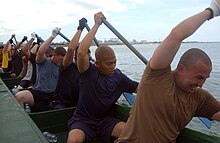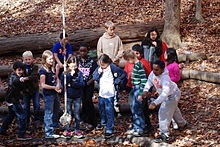
Back عمل فريق Arabic দলগত কাম Assamese Treball en equip Catalan Teamwork Danish Gruppenarbeit (Arbeitsorganisation) German Trabajo en equipo Spanish Meeskonnatöö Estonian Lan-talde Basque کار گروهی Persian Travail en équipe French





Teamwork is the collaborative effort of a group to achieve a common goal or to complete a task in an effective and efficient way.[1][2] Teamwork is seen within the framework of a team, which is a group of interdependent individuals who work together towards a common goal.[3][1]
The four[clarification needed] key characteristics of a team include a shared goal, interdependence, boundedness, stability, the ability to manage their own work and internal process, and operate in a bigger social system.[4]
Teams need to be able to leverage resources to be productive (i.e. playing fields or meeting spaces, scheduled times for planning, guidance from coaches or supervisors, support from the organization, etc.), and clearly defined roles within the team in order for everyone to have a clear purpose.[5] Teamwork is present in contexts including an industrial organization (formal work teams), athletics (sports teams), a school (classmates working on a project), and the healthcare system (operating room teams). In each of these settings, the level of teamwork and interdependence can vary from low (e.g. golf, track and field), to intermediate (e.g. baseball, football), to high (e.g. basketball, soccer), depending on the amount of communication, interaction, and collaboration present between team members.
Among the requirements for effective teamwork are an adequate team size. The context is important, and team sizes can vary depending upon the objective. A team must include at least two members, and most teams range in size from two to 100. Sports teams generally have fixed sizes based upon set rules, and work teams may change in size depending upon the phase and complexity of the objective.
- ^ a b Montebello, Anthony R.; Buzzotta, Victor R. (March 1993). "Work Teams That Work". Training & Development. 47 (3). Archived from the original on 2018-02-26.
- ^ Salas, Eduardo; Cooke, Nancy J.; Rosen, Michael A. (2008). "On Teams, Teamwork, as well as Team Performance: Discoveries and Developments". Human Factors: The Journal of the Human Factors and Ergonomics Society. 50 (3): 540–547. doi:10.1518/001872008X288457. PMID 18689065. S2CID 17017793.
- ^ Parker, Glenn (2008). Team Players and Teamwork: New Strategies for Developing Successful Collaboration. San Francisco: Jossey-Bass. pp. 1–68. ISBN 978-0-787-99811-0.
- ^ Thompson, Leigh (2011). Making the Team: A Guide for Managers (4th ed.). Upper Saddle River, New Jersey: Prentice Hall. ISBN 978-0-13-014363-1.
- ^
- Chang, Artemis; Bordia, Prashanti; Duck, Julie (2003). "Punctuated Equilibrium and Linear Progression: Toward a New Understanding of Group Development". Academy of Management Journal. 46 (1): 106–117. JSTOR 30040680.
- Gersick, Connie (1991). "Revolutionary Change Theories: A Multilevel Exploration of the Punctuated Equilibrium Paradigm". Academy of Management Review. 16: 10–16. doi:10.5465/amr.1991.4278988. S2CID 13960681.
- West, Michael (2012). Effective Teamwork: Practical Lessons from Organizational Research. Wiley-Blackwell. ISBN 978-0-470-97498-8.
- Woods, Stephen; West, Michael (2014). The Psychology of Work and Organizations. Andover: Cengage Learning EMEA. ISBN 9781408072455.